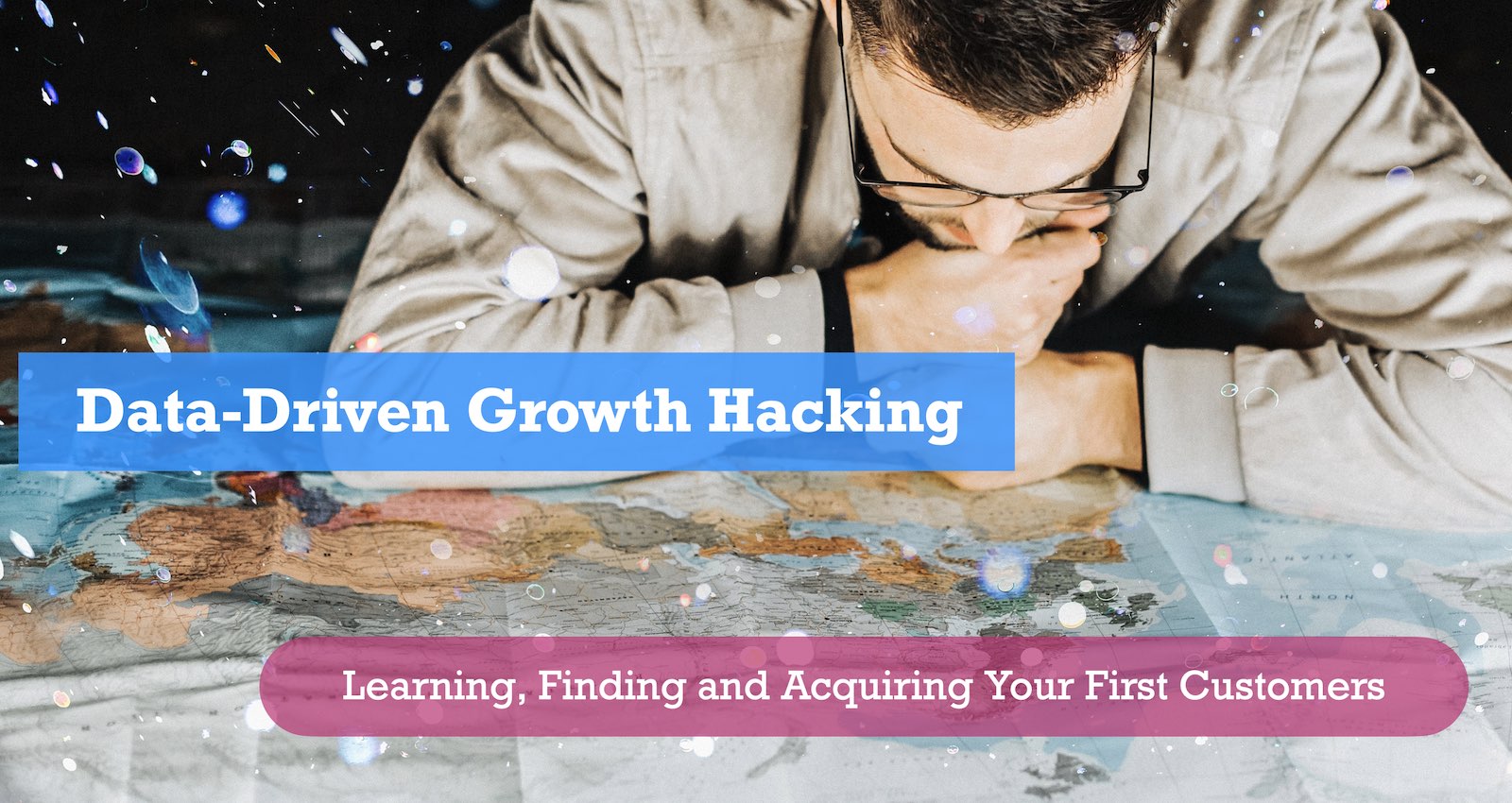How can you start growing a business, startup or side hustle when you aren’t even sure who your customers are or even how to reach them?
Try data-driven growth hacking, an experimental, user-centered learning approach to marketing and growth.
One of the biggest challenges facing any venture is uncertainty. How do we derisk a business and learn what we need to know to act?
Inspired by Lean Startup, User Experience Design (UX) and my work at Techstars and other growth-oriented startups, I believe data-driven growth hacking can offer a powerful mindset and iterative process for finding your first customers, experimenting with different traction channels, and identifying effective messaging and value propositions that resonate with your customers. It’s a way of dealing with uncertainty and developing a repeatable growth engine for any type of business.
Whether you call it growth hacking or growth or digitial marketing, it is essentially about reaching and selling to customers. We add data and analytics to capture what customers do and track how you do over time. By leveraging growth hacking as a data-driven, iterative, experimental approach to marketing, we can improve our rate of learning, discover key customer insights and drive better results in your product, growth or business decisions.
Over the past couple years, along side my primary role as a product designer and software engineer, I’ve also lead growth and marketing sprints at several early-stage companies, including a life science startup, a tour operator, an ecommerce shop and even one or two of my own businesses. While more established companies have the ability to split up many of these marketing, design, engineering and analytics responsibilies, new ventures rarely have this luxury. In search of customers and a repeatable path to growth, it has often been my responsibility to bridge user research, marketing and tech. In practical terms, I’m often the guy to first setup our website, configure analytics, launch online ads and create our traction dashboards.
Even though growth hacking is closely tied with all forms of digital marketing and sales, I personally take a lot of my inspiration from Eric Ries’s Lean Startup, Steve Blank’s Customer Development, key aspects of user experience design (UX), and most recently the book “Levers” by Amos Schwartzfarb and two other directors at Techstars. Growth Hacking is particularly associated with tech startups in pursuit of product-market fit, acquiring early users and long-term repeatable traction. But I strongly believe these techniques and tools are useful to any business or organization looking for users. For example, it even applies at nonprofit looking for volunteers or donors.
In this post, I’ll articulate the core components of data-driven growth hacking. First, I’ll layout the context in which I believe growth hacking fits, namely dealing with uncertainty and the value risk facing any new venture with their customers. After, I’ll summarize my take on what is growth marketing and share some key mental models and approaches I have utilized with some of the companies and startups I have worked at.
NOTE: For the sake of brevity, I’ll largely focus on the strategic components and leave the tactical aspects (like sales funnels, dashboards and running traction experiments) for future posts.
Uncertainty and Risks Facing Any New Venture
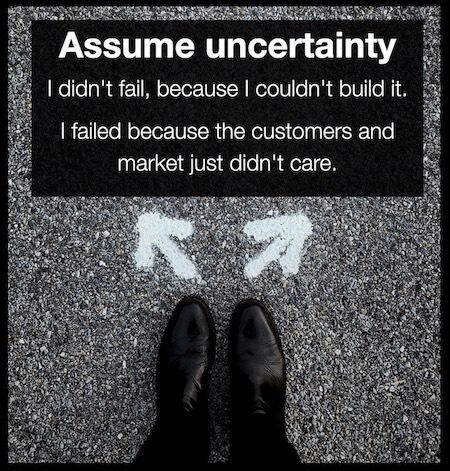
Like it or not, all businesses face uncertainty. Uncertainty refers to knowledge or epistemic situations in which you have imperfect or unknown information. You never have complete information about any game or decision you make in a business, life or otherwise. You can’t predict how any choice will entirely play out. Put another way, it should be basically assumed that we do not with complete certainty know the future nor do we really know the past either, and, in fact, in many ways we don’t have complete information or knowledge of the present either.
Assume uncertainty.
The COVID-19 Pandemic is testiment to the changing power of a once-in-a-century event, and both established and new companies have had to adjust their approaches to doing business today.
Established, successful companies largely have the advantage of knowing what they are doing, what has been working and why. They have more data points in the past to help them guide their present and future choices. They still have uncertainty in their business practices and often don’t see disruptions on the horizon (Think Blockbuster with Streaming). The amount of uncertainty in core components of established businesses is less than any new venture. Well-established companies with a track record of success have dealt with the central uncertainties at the heart of their business model and have overcome key risks around their customer, market and product or service. They may not know everything but they know something.
By contrast, unlike established companies, new business ventures and startups face an extremely high degree of uncertainty and risk. Unlike experienced companies, we often don’t know who are customer is, how to reach them or even the exact product or service we will develop.
Startup Investor and Stanford Professor Steve Blank highlighted two risks all companies face, namely:
- Value Risk: Is our product or service valuable to our customers? Will users choose to use it? Will they buy it?
- Invention Risk: Is it possible and feasible to build the product or technology our customers want?
Along with Value and Invention Risks, I would add a few others:
- Usability or UX Risk: Can we design and deliver a user experience our users find usable and hopefully enjoy using?
- Business Viability or “Sustainable Cost of Doing Business” Risk: Do the economics of the venture even work? Is revenue earned greater than the cost of acquiring a customer and delivering the product or service to them? Can we one day be profitable?
While not applicable for many companies especially software companies, in my experience with life science and deep tech companies, I would also include what I call the Science Risk. Does the science work we way we need it to in order to deliver a valuable, useful and viable product or service for our customers? Are the physics or biology such that we can engineer a customer-centric solution or research-benefiting technology? Put another way, does the world work in the way we need to to do our business?
As an engineer and science geek, I love building stuff. Unfortunately, I’ve built and launched quite a few products that technically worked but lacked customers or a viable market.
I didn’t fail, because I couldn’t build it. I failed because the customers and market just didn’t care.
While admittedly invention risk is also essential, I believe the central concern for any and all early stage ventures should be on your value risk or value-exchange risk:
Do customers actually want and will pay for the value you plan to sell?
As a new venture or startup, how can you be sure that the value you plan to create or problem you intend to solve matters to your customers?
Along with UX Design, Data-Driven Growth Marketing offers some useful techniques for dealing with customer value uncertainty.
Dealing with Uncertainty and Risk: An Experiment-Driven Progress Path
In their book, “Testing Business Ideas,” David Bland and Alex Osterwalder offer dozens of activities for testing and validating business ideas. Underlying these individual experiments is what I’d like to call an “Experiment-Driven Progress Path,” which they summarized visually extremely well in the open pages:
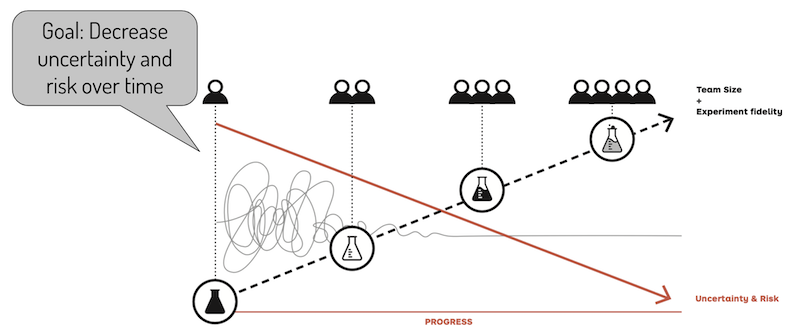
Source: Bland, D. J., & Osterwalder, A. (2019). Testing Business Ideas. John Wiley & Sons.
What this graphic shows is that individual founders face the highest amount of uncertainty. Most of what they “know” is, in fact, assumptions. Moreover, even if the founding teams has the most sophisticated plans for execution, their path will in reality be pretty messy, go up and down, and twist in convoluted ways.
Fortunately, over time and assuming that they use an experimental and test-driven approach, their uncertainties should decrease, the riskiness of the venture should go down, and they should be able to grow their company with greater confidence and high probability of success in the future.
Derisking should be the central activity at any venture. Fortunately, by running experiments, the team can and should make progress towards decreasing uncertainty and risk over time.
While a startup or new venture encompasses many more facets that require derisking, we as growth hackers in one form or another can also benefit from a similar Experiment-Driven Progress Path. By thinking about every aspect of our marketing and growth as growth experiments, we can position them to maximize our learnings. We can think of our advertisements and marketing copy as trials in understanding who are customers are, what they care about, and how to reach them in reliable, repeatable ways.
Combined with UX design practices, we can iteratively learn and develop not only a path to growing our customer base but also gain tangible insights into the products and services we design and build.
Learnings: Your Strongest Lever Against Uncertainty
In spite of how central uncertainty and risk are in all ventures (and all human life for that matter), it surprises me how little the topic comes up. In fact, I often meet early-stage founders and CEOs who confidently flount their pitch deck or business model as if success was predicated on vision and execution alone. They create a grand narrative about their future customers without much effort talking to their current or potential customers.
There is no other way to put this then to recognize that lots and lots of founders and business leaders today are blind to the assumptions, risk and uncertainty they face. They live in a bubble of their own confirmation bias.
Sadly, most startups and new companies will fail. They fail for any number of reasons. In my experience at Techstars and other early-stage accelerators, one of the most common are inter-social conflicts on the founding team (i.e. founder breakups). But more often than not, the real problem is not recognizing how much uncertainty their business faces and failing to act to reduce those fundamental uncertainties.
I believe one of most fundamental deriskers you should focus on when dealing with uncertainties in a new business venture are learnings.
For me, learnings is a catch-all phrase to encapsulate all of the important insights you should have about your business. Learnings are intended to break us out of our uncertainty and confirmation bias bubbles. They serve to create a shared unit of analysis around what we know and don’t know. Ideally these learnings should always be phrased in the language of data, meaning you know it because you have data to show.
In Lean Startup, learnings are viewed around the product and build-measure-learn cycles. For Steve Blank’s Customer Development methodology, learnings are built around the user, namely, as he puts it, “acquiring a deep understanding of customer needs” through customer discovery or customer validation. For UX and User Research, learnings are developed through user interviews and user testing.
Practically-speaking, it’s about converting your biggest assumptions into things you actually know. There are really only two ways to derisk your assumptions, by either talking to customers or getting real-world data through experiments.
Growth hackers and marketers also face lots of uncertainty. We don’t know exactly who are customer is or how to reach them. We don’t know if what worked over the last few weeks will continue to work going forward. Frankly, like all of us, we are biased towards confirmation and a host of other cognitive biases (like recency and relevance) limiting our ability to recognize that ultimately we don’t know what we don’t know.
As such, learnings are also extremely important for growth hackers and growth marketers. Fortunately, growth marketers face their uncertainty with one of the greatest deriskers for any business: traction.
Traction: Your Biggest Derisker of Customer Value for Growth Hackers
Paul Graham of Y-Combinator writes that “Traction = Growth,” and Naval Ravikant defines traction as “quantitative evidence of market demand.” However you want to define it, traction is essentially the growth you find in any business venture. Both for entrepreneurs and stakeholders in any business, traction represents a singular metric of progress. It’s a demonstrable metric showing customer desire and economic uptake of your product or service.
As Gabriel Weinberg, founder and CEO of DuckDuckGo and author of one of my favorite startup books, “Traction,” puts it, “Traction Trumps Everything.”
If the customer value is one of the cornerstones for any business model and one of the most important business components you need to derisk, then traction is one of the most black and white ways to show you are creating and capturing customer value. Traction tells you with data that customers are there in a particular market and you are reaching them.
Unlike vanity metrics like forming a company, having a good team, shipping product or even social proof, traction represents a clear way of measuring how many customers you are reaching and exactly how many of them are acting on it, i.e. signing up, joining, buying, volunteering, sharing or taking some other demonstrable act that grows your venture.
While many parts of an organization or startup can demonstrate progress in terms of execution or “doing stuff,” growth marketers along with the product team are often times one of the most customer-aligned or customer-centric parts of a company.
Customer centricity is fundamental and of utmost important to any business venture. Having worked with hundreds of startup founders over the years, including my time launching Techstars in China, nearly every single successful founder I’ve known were a case study in being not just customer-centric but frankly customer-obsessed. I consider talking customers to be THE fundamental first step in any venture. Professionally UX and customer discovery are regular components of my work. Talking to customer is often an early signal and VC filter of a good startup team.
[Side Note: Honestly, if you want to check on the seriousness of any new startup venture or how well they care about their users, just ask the founding team how many of their customers have they talked to (today, this week, this year, etc.)? If they can’t answer directly with tangile customer stories, they aren’t close enough to their customers.]
While admittedly growth hackers and digital markers might not have the time to singularly focus on talking to customers, user research or qualitative research like UX designers, we all need to still be asking: Who is the customer? What are their problems, needs and opportunities? What value are we creating through our mission, story and products? The only difference between a UX designer and a growth hacker is the type of data we use. UX Designers bring qualitative data while digital marketers bring quantitative data in the form of traction metrics.
What is Data-Driven Growth Hacking?
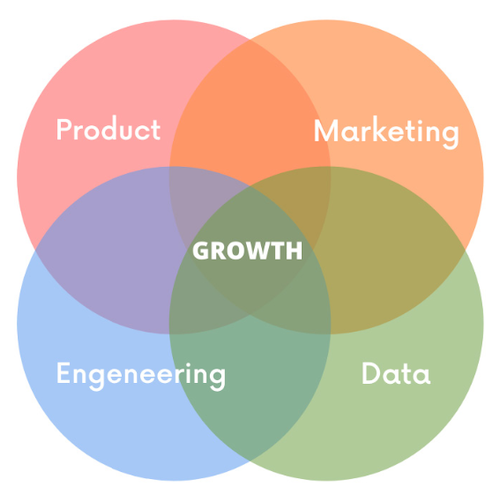
Today’s “growth hacker” leverages skills in design, marketing, product, engineering, and even data science. While the goal is traction and conversions, the activities to get traction often combine aspects of customer discovery, creative marketing, customer service, and, ultimately, sales. Like it or not, a modern growth hacker especially in early-stage ventures needs to be a jack-of-all-trades generalist with a marked focus on finding, reaching and selling to customers.
Personally, I define growth hacking as a customer-centric, data-driven, experimental, iterative approach to creative digital marketing.
- Customer-centric means your marketing and growth are all about bringing your message, movement, product or service to your customer. You serve the customers.
- Leaving aside the technical details (which I’ll cover elsewhere), data-driven growth hacking boils down to capturing all of the necessary end-to-end data and analytics to understand your customer’s journey from discovery to enlightenment to commitment. Basically you are measuring how a customer becomes aware of you up until they convert or purchase your service.
- Experimental means you recognize the assumptions and uncertainties in your work as a marketer. While you might have experience or a track record of what worked before, each marketing campaign represents a new hypothesis about our customer, our understanding about them and our approach to traction and growth.
- Whether it’s design, engineering or marketing, being iterative boils down to undergoing a series of steps from research to hypothesis formation to testing to data analysis to learning. Iterations enables on-going processes towards innovation, feedback and traction-focused progress. If you aren’t iterating, you aren’t learning.
- Unlike traditional forms of digital and nondigital marketing, growth hacking is not just limited to standard traction channels, like paid advertising or SEO. Growth hacking often strives for and is associated with unique traction hacks, like Dropbox’s pre-launch video demo or AirBnB’s cross-posting their first listings on Craigslist. As such, it is important to realize that creativity isn’t just for the designers. In actually everyone including marketers need to be creative.
Data-driven growth marketing is about capturing end-to-end data about your sales funnel and doing a series of iterative growth experiments towards finding, understanding and capturing your customers.
By tracking your marketing and conversion metrics, you can monitor the core numbers that drive your business and, in turn, create a sales funnel that helps you see and break down your business into repeatable growth engines you can iterate on. What matters is having data to understand the key touch points in your “sales” funnel from when a customer first becomes aware about your product or service to learning about the details to finally joining.
Tactically this often involves tracking clicks on your ads and blog content, monitoring engagement on your website or app, and recording goals and conversions, like a newsletter signup or paid transaction. Typically the end result is a comprehensive tracking or traction board where you can see in one place how your ads (and experiments) are performance, current user behavior, and your main KPIs, like signups and revenue.
Here is an example of one of my traction boards:
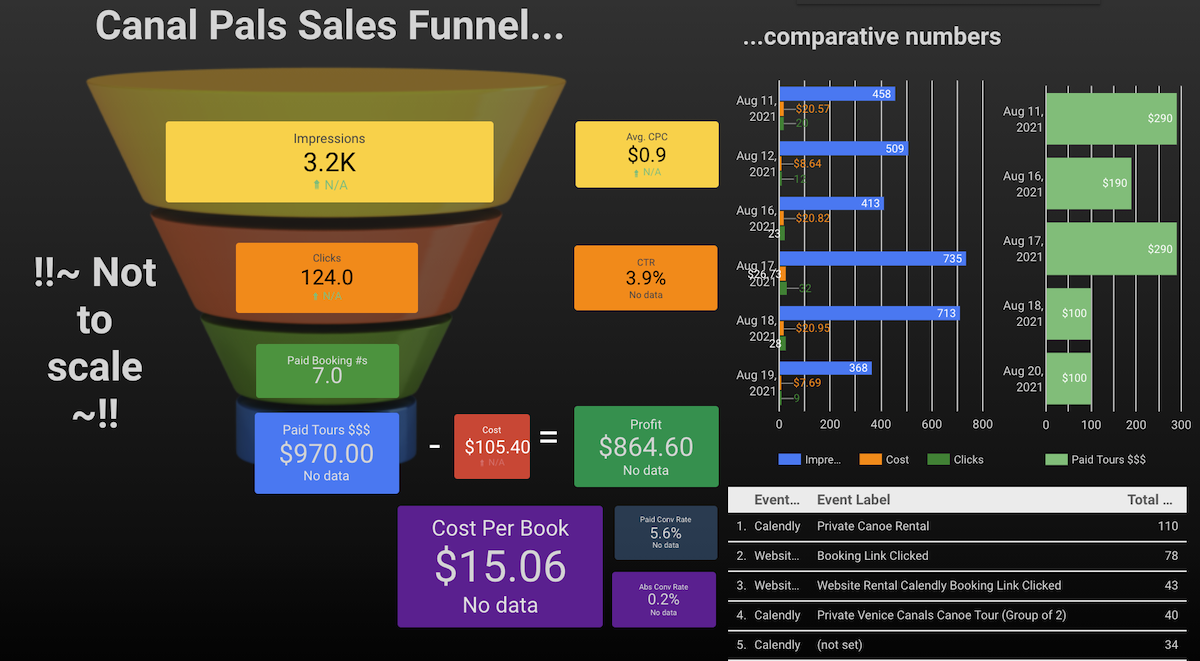
Sales Numbers for Canal Pals, my canoe tour business in Venice, California.
Conclusion: Using Data-Driven Growth Hacking to Find, Acquire and Understand Your First Customers
We’ve all met founders or startup enthusiasts who are so confident in their startup idea that they are afraid to even share it with you (at least without a signed NDA). While great ideas are important, rarely (if ever) is a great idea sufficient to create a successful product or service customers care about. Because startups face so much uncertainty and numerous risks, it’s essential to avoid any singular vision or inflexible plan. We all need to recognize and avoid confirmation bias and many other psychological barriers that prevent us from optimal thinking and deciding. What matters is recognizing uncertainty and derisking the fundamental aspects of what makes a business work, namely its customers.
Customers should be at the heart of what we do in any business.
Traction represents the clearest and most demonstrable metric for showing with data that your business understands its users and knows how to find, acquire and service its customers.
Like UX Design, which is another of my favorite mental models and tools for business development, growth hacking or growth marketing offer a powerful process and toolkit for bringing customers in a repeatable way to any business.
In this post, we looked at what is growth hacking with a particular eye towards the need for any business to derisk and deal with uncertainty. We looked at different types of risks that exist and honed in on the customer value risk. At the end of the day we need (relative) certainty and proof that the value we create is a value our customers will pay for. We then laid how traction, especially when measured with our end-to-end analytics, might just be the biggest derisker of customer value for Growth Hackers today. We ended with my definition of growth marketing as customer-centric, data-driven, experimental, iterative approach to creative digital marketing.
While this post largely focused on the strategic and mental models we can bring to understanding our customers and growth, it’s important to recognize that growth marketing is largely an experiential and tactical approach. It’s about running growth experiments to help validate who are customer is and how best to reach them and then to iterative improve over time.
Through a series of growth experiments, you are able to effectively find the most cost effective ways to reach new customers and which types of messages resonate with different customer segments. By iterating on different aspects of your sales funnel from traction channel and ad copy to landing page and messaging, you can effectively hone in on what works and what doesn’t it.
It’s about repeatedly thinking about and thinking about thinking about your customers and approach to growth.
While as a product designer customer development and qualitative research remain central to much of my work, I’m increasingly convinced that digital marketing and growth hacking can offer new insights into our customers and market. Talking to customers should be where all business start, but ultimately a great product or service without traction and growth will fail. So, the sooner you find repeatable traction the better.
Inspiring Marketing and Growth Books I Love and Recommend:
This blog post and much of my thinking would not have been possible with reading and re-reading several books and blog posts. These four were particularly helpful:
- Traction: How Any Startup Can Achieve Explosive Customer Growth by Gabriel Weinberg
- Levers: The Framework for Building Repeatability into Your Business by Amos Schwartzfarb
- This is Marketing by Seth Godin
- Who Do You Want Your Customers to Become? by Michael Schrage

